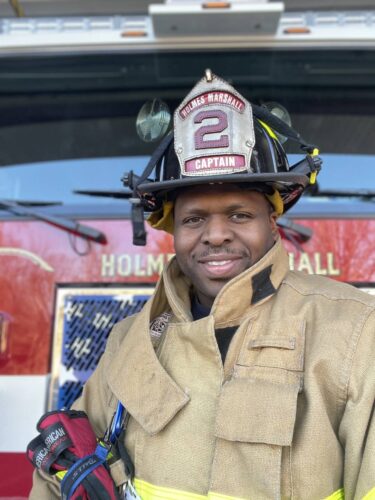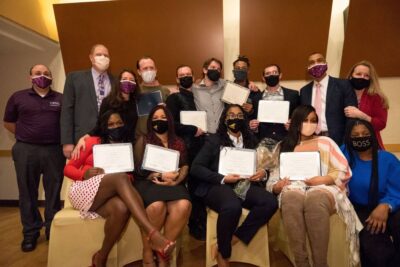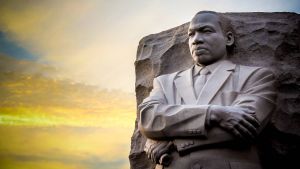In 2019, Hope Gray took a ride in an ambulance after suffering from a heart attack while she was out at Walgreens.
While she knew she was having a heart attack, the paramedics that responded to her 911 call told her she was having a panic attack, and that’s what they told the nurses and doctors when they took her to the hospital. All the EMS team members in the ambulance were white.
“Consider if there were some African American people on that ambulance,” Gray said. “Maybe they would have considered I was telling the truth, and something was really wrong with me. Maybe they would have done the handoff a little differently.”
Gray, who is a Board Certified Chaplain with experience serving as a hospital, hospice and corporate chaplain, told the EMTs and paramedics about her symptoms and her experience handling handoffs before. Despite this, the EMTs continued to tell the hospital she was having a panic attack. She’s also now a member of The PhD Project and a predoctoral trainee in Administration – Health Services with a concentration in Health Informatics at the University of Alabama Birmingham.
“So, how did they treat me when I got to the hospital? They treated me by giving me a sedative to calm down. Meanwhile, I was having a heart attack,” she said.
Her friends came to the hospital to support her, and the hospital staff told them she was fine and that they could go home.
“Here I am as a single Black female being treated by all white people, all white males mind you, and the only Black person was the clerk taking payments,” Gray said. “I got to the hospital at 1 o’clock. They did not take me to have two stents until 6 o’clock in the evening. Imagine the damage that was doing to my heart because I didn’t have a paramedic or a nursing staff that believed I was having a heart attack.”
Representation Among First Responder Positions
When considering the small number of people of color who serve as EMTs and paramedics, the fact that Gray was treated by an all-white crew of first responders comes as no surprise.
According to research studying the employment characteristics of emergency medical technicians and paramedics in the United States from 2011 to 2019, most people holding these positions are non-Hispanic white, even with a decrease of 8% over eight years.
The total number of Latino or Hispanic EMTs and paramedics in the country did increase from 10% of the workforce in 2011 to making up 13% of it in 2019, but the number of people in the field identifying as non-Hispanic Black hasn’t changed much over the years (7% in 2011 to 8% in 2019).
The lack of diversity in first responder roles has led to a disconnect between those who are responding to emergency situations and the people who are experiencing these emergencies, meaning that other people from underrepresented communities are, like Gray, often not being heard and are not receiving the best treatment.
In an article written for Northwell Health (No. 1 on Fair360, formerly DiversityInc’s 2022 Top Hospitals and Health Systems list), Bernard Robinson, Director of Operations for the company’s Center for Emergency Medical Services, said cultivating diversity in the emergency services field starts with improving the cultural humility and competence of EMTs and paramedics.
“They need to take to heart that we always have something to learn from our patients. Listening will only make us better at what we do,” he wrote.

The fire service is another branch of first responders that doesn’t have much minority representation. Sixty-nine percent of firefighters are white, 15.3% are Hispanic or Latino and only 8.1% are Black or African American.
Brian Agnew, who is Assistant Chief of the Holmes County Marshall Fire Company in Piscataway, New Jersey, has been a volunteer firefighter for 17 years and was the first African American member of the first department he worked for.
To create more minority representation in the fire service field, Agnew said he wants to serve as a role model for young professionals coming into the industry.
“I feel this way about a lot of things,” Agnew said. “I have a doctorate, and I think it was helpful to see others who look like me in the industry, so that when I needed advice and counsel, I felt comfortable with their background, their experiences, which were shared backgrounds and shared experiences. I think that will be the biggest shift we’ll need to see in the future of the fire service.”
As Assistant Chief, Agnew is mentoring young men of color in urban environments on the opportunities presented in the fire service while also teaching the next generation of firefighters in the state of New Jersey.
“At the end of last year, I completed and passed my New Jersey State Level 1 Fire Instructor Certification, and I am currently taking my Level 2 Fire Instructor Certification,” he said. “In that sense, this is the certification that allows you to train the next generation of firefighters.”
“It’s great to talk about it, it’s great to share experiences, it’s another thing to be in the front of the classroom to be a person that can mentor and guide you on the front lines in the academy,” Agnew added.
Hiring More People of Color in Emergency Service Positions
In Allegheny County and the Pittsburgh area, the University of Pittsburgh Medical Center (UPMC) has partnered with workforce development organization Partner4Work to employ more people of color in the EMS field through a program launched in late 2020 called Freedom House 2.0. The program is named after the original Freedom House, an ambulance service established in 1967 and staffed mostly by Black Americans. It was shut down in 1975 and Black first responders were replaced by white ones.
Dan Swayze, UPMC Health Plan Vice President of Community Services and Director of Operations, UPMC Innovative Health Care Solutions, said it is “critically important” to offer this training to hire more EMTs of color and provide better treatment to underserved communities.
“We cannot continue to have people in it that look like me,” he said.

The Freedom House 2.0 training program, which was changed from an initial 10-week course to a five-week course based on feedback from students, is funded through a $235,000 grant through Partner4Work and is free for students to enroll in. The only requirement is to be at least 16 years of age and ready to commit to the full program.
Susie Puskar, Chief Policy and Research Officer at Partner4Work, said an important aspect of the program is the different career pathways graduates are able to take.
“There are some people who become an EMT, and they love it and they thrive there and that is what they want to do as their career,” she said. “There are others where an EMT position is one step on a career pathway and what they are really interested in is becoming a paramedic or an RN or another clinical role in the healthcare system.
“What we’ve worked on with UPMC is really making those pathways explicit to students in the course and within UPMC so once someone is hired, they have a real opportunity to engage in additional training and learning and access to benefits offered through UPMC.”
Getting the Word Out About EMT and Paramedic Jobs
Why are there fewer people of color in EMT and paramedic roles? Gray believes a lack of knowledge surrounding these career fields is partially to blame.
“There’s a lack of knowledge in terms of people knowing this is something they can do,” she said. “It’s not something that’s on their radar. When young people are coming up, for example, they know they can be a nurse, they know they can be a doctor. But who has ever said, ‘have you considered being an EMT, being a paramedic, making sure that patients get to the hospital to get to the nurse and to the doctor?’”
Some organizations have plans in place to address and hopefully help demographics within the field evolve.
Jefferson Health (No. 8 on Fair360, formerly DiversityInc’s 2022 Top Hospitals and Health Systems list) trains approximately 5,000 students in the Greater Philadelphia and South Jersey area every year in roles like EMT, paramedic, advanced cardiac life support, CPR and more through its JeffSTAT Education Center.
Cathleen Vandenbraak, Operations Manager of the JeffSTAT Education Center, said the organization has done a lot of outreach within the local community to encourage students to go down one of these career paths. In April, they will take part in a career fair at a local high school in Philadelphia to talk about the medical field. She is also reaching out to one of the local ambulances JeffSTAT works with and a nursing school to talk to students about what Jefferson Health does.
“A lot of people don’t know what it is to be an EMT or a paramedic or a nurse and what it is they need to do, so we’re starting to really ramp that up a lot more,” she said.
Overcoming the Pay Barrier
Another barrier that might be keeping people of color out of EMT roles is the low pay, long hours and high stress, which often leads to high turnover in the field.
According to the Bureau of Labor Statistics, the median salary for EMTs in 2021 was $35,470, which was approximately 34% less than what the median American worker was bringing home that year. While this number was lower, paramedics were making a bit more at $46,770 annually.
Since Freedom House 2.0 knows being an EMT or a paramedic is a high-stress job, Puskar said the program has made it a focus to provide mental health resources to students in the program.
“These are roles that do witness a lot of trauma as a part of their job, and so really making sure that the trainees get access to support even before they start on the job so they understand how to process all of this. And here’s how I can make sure that I’m not as affected by secondary trauma, for instance,” she said.
While the pay has gotten better across emergency service roles, it’s not where it needs to be yet. To make it in these roles, Vandenbraak said it’s something you have to be passionate about.
“An EMT can actually be the first person on the scene to do CPR and save a life,” she said. “It has to be the impact, it has to be the inner drive. To do this just for money, there are probably other things to do just for money.”
People who want to be EMTs, paramedics, nurses or any type of first responder should know they will have to work the day shift, night shift and holidays.
“You have to change things around your life,” Vandenbraak said. “It’s a part of the job, unfortunately, because we are that important. We have to be there 24/7.”


















